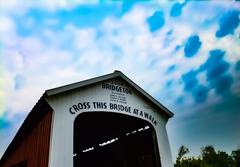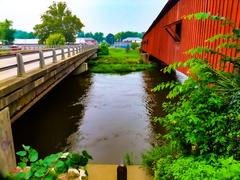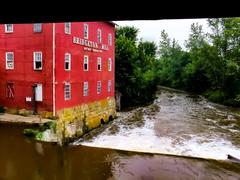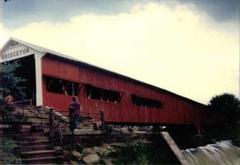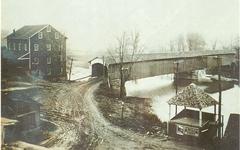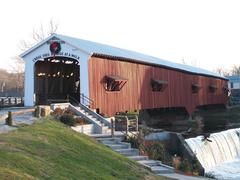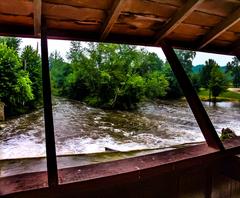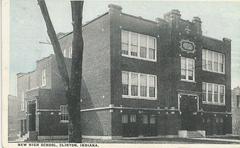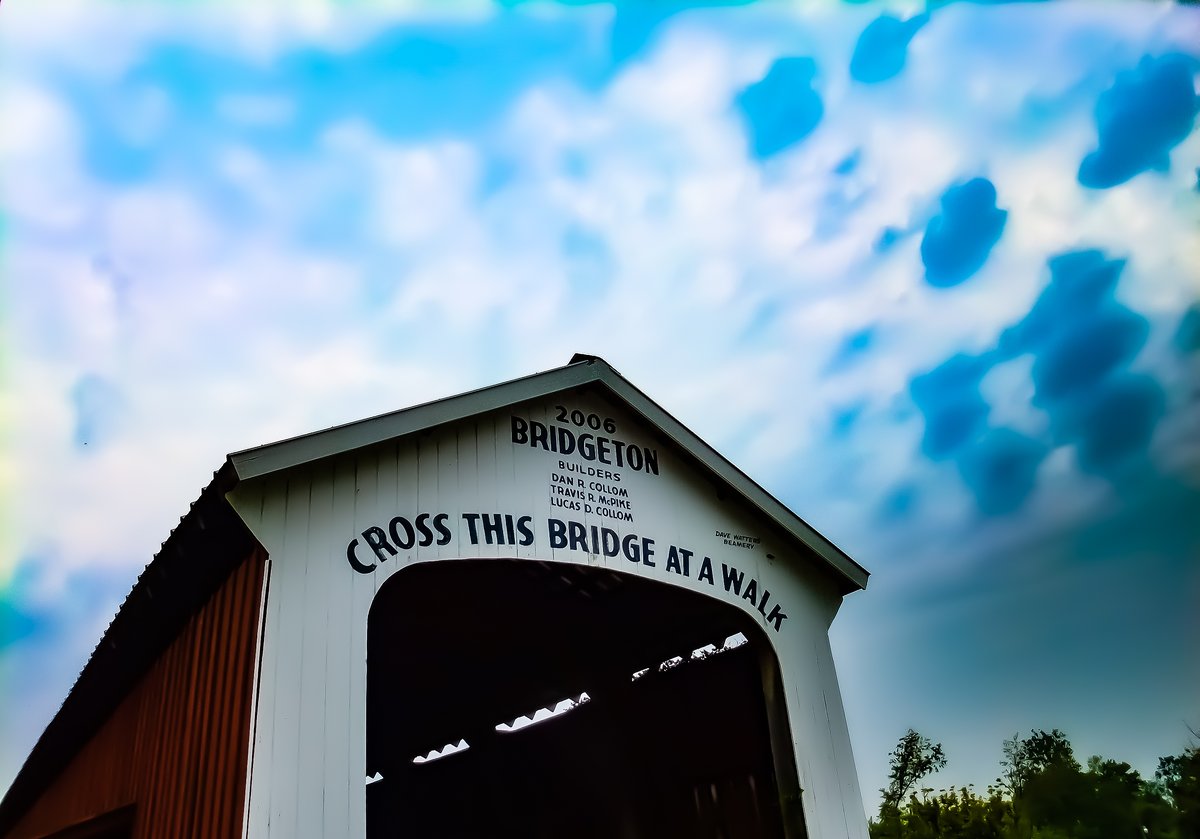
Visiting Bridgeton Covered Bridge: Hours, Tickets, and Historical Significance
Publication Date: 31/07/2024
Introduction
Nestled in the heart of Parke County, Indiana, the Bridgeton Covered Bridge stands as a captivating piece of American heritage. This historical structure, located in Bridgeton, Indiana, draws thousands of visitors each year with its picturesque views, rich history, and cultural significance. The bridge, originally constructed in 1868 by J.J. Daniels, a renowned bridge builder of the time, has undergone numerous transformations and restorations, particularly after the tragic arson event in 2005 (Wikipedia). The bridge is a quintessential example of the Burr Arch Truss design, known for its strength and durability, which was a popular architectural style for bridges in the 19th century.
The Bridgeton Covered Bridge is more than just a functional structure; it is a cultural landmark that has played a significant role in the community of Bridgeton and the broader Parke County. Visitors can explore the nearby historic Bridgeton Mill, enjoy the annual Covered Bridge Festival, and participate in guided tours that offer in-depth insights into the bridge’s history and significance. This comprehensive guide aims to provide all the essential information for a memorable visit, including visiting hours, ticket information, travel tips, and nearby attractions. Whether you’re a history buff, an architecture enthusiast, or simply looking for a serene escape, the Bridgeton Covered Bridge offers a unique window into the past.
Table of Contents
- Introduction
- Early Beginnings and Construction
- The First Bridge: 1868-1967
- Destruction by Arson
- Rebuilding the Bridge: 2006
- The Bridgeton Mill
- Significance of the Covered Bridge
- The Covered Bridge Festival
- Preservation and Tourism
- Visitor Information
- Special Events and Guided Tours
- Frequently Asked Questions (FAQ)
- Conclusion
Early Beginnings and Construction
The Bridgeton Covered Bridge, located in Bridgeton, Indiana, has a storied history that dates back to the mid-19th century. The first covered bridge at this location was a double-span Burr Arch bridge constructed in 1868 by a team led by J.J. Daniels. This bridge was built to replace two earlier open wooden bridges that had collapsed (Wikipedia). The Burr Arch design, known for its strength and durability, was a popular choice for covered bridges during this period.
The First Bridge: 1868-1967
The original Bridgeton Covered Bridge served the community for nearly a century. It was closed to vehicular traffic in 1967, marking the end of its primary use. The bridge’s longevity is a testament to the craftsmanship and engineering skills of its builders. During its operational years, the bridge was an essential part of the local infrastructure, facilitating transportation and commerce in the region (Covered Bridges Guide).
Destruction by Arson
Tragically, the original Bridgeton Covered Bridge was destroyed by arson on April 28, 2005. Jesse Payne was apprehended near the Mansfield Covered Bridge shortly after the incident and was suspected of burning the Jeffries Ford Covered Bridge and attempting to set fire to the Mansfield Covered Bridge as well. Due to his mental state, Payne was detained at the Logansport State Hospital until he was deemed fit to stand trial (Wikipedia).
Rebuilding the Bridge: 2006
In response to the arson, the local community and the state of Indiana rallied to rebuild the Bridgeton Covered Bridge. The new bridge, completed in 2006, is a faithful reproduction of the original structure. This effort was a significant undertaking, reflecting the community’s dedication to preserving its historical landmarks. The new bridge continues to serve as a symbol of resilience and heritage for Bridgeton (Wikipedia).
The Bridgeton Mill
Adjacent to the Bridgeton Covered Bridge is the historic Bridgeton Mill, which has its own rich history intertwined with that of the bridge. The first mill at this location was built around 1823 by Kockwood and Silliman. Over the years, the mill changed hands multiple times and underwent several reconstructions due to fires and other damages. The current mill, rebuilt in 1871 by James Rea, remains operational and continues to grind cornmeal and flour, offering visitors a glimpse into the past (Wikipedia).
Significance of the Covered Bridge
The Bridgeton Covered Bridge is not just a functional structure but also a cultural and historical icon. Covered bridges were originally designed to protect the wooden structural elements from the elements, thereby extending their lifespan. The inscription found on many covered bridges, including those in Parke County, dates back to the horse-and-buggy days. This instruction was meant to minimize the rhythmic pounding of horses’ hooves, which could cause more structural damage than the weight of modern vehicles (Covered Bridges Guide).
The Covered Bridge Festival
The Bridgeton Covered Bridge is a central attraction during the annual Covered Bridge Festival, held every October. This festival celebrates the rich history and craftsmanship of covered bridges in Parke County, which is known as the “Covered Bridge Capital of the World.” The festival attracts over a million visitors each year, offering a variety of activities, including tours of historic sites, artisan markets, and local food vendors (Covered Bridge Festival).
Preservation and Tourism
Today, the Bridgeton Covered Bridge is a popular tourist destination, drawing visitors from around the world. The bridge, along with the Bridgeton Mill, is listed on the National Register of Historic Places, ensuring its preservation for future generations. The community’s efforts to rebuild and maintain the bridge highlight the importance of preserving historical landmarks as a way to connect with the past and educate future generations (Covered Bridges Guide).
Visitor Information
Visiting Hours and Tickets
- Visiting Hours: The Bridgeton Covered Bridge is accessible year-round. However, the Bridgeton Mill has specific operational hours, which vary by season. It is advisable to check their official website for the most current information.
- Tickets: There is no admission fee to visit the Bridgeton Covered Bridge. However, donations for the maintenance and preservation of the bridge are always welcome.
Travel Tips
- Best Time to Visit: The Covered Bridge Festival in October is the most popular time to visit, but the bridge and mill are accessible year-round.
- Location: The bridge is located at 8132 Bridgeton Road, Bridgeton, Indiana.
- Nearby Attractions: In addition to the bridge and mill, visitors can explore other historic sites in Bridgeton, such as the Old Ford Garage, Old Firehouse, and the 1874 Old Town Hall (Bridgeton Indiana).
- Food and Shopping: The town offers a variety of unique shops and eateries, many of which are housed in historic buildings. Popular spots include the Bridgeton 1978 House and Ye Olde Covered Bridge Shoppe (Covered Bridge Festival).
Special Events and Guided Tours
The Bridgeton Covered Bridge is not just a historical landmark but also a venue for various special events throughout the year. Guided tours are available, offering in-depth insights into the bridge’s history and significance. Photography enthusiasts will find numerous picturesque spots around the bridge and mill, making it a perfect destination for capturing memories.
Frequently Asked Questions (FAQ)
- Is there an admission fee to visit the Bridgeton Covered Bridge?
- No, there is no admission fee. Donations are welcome.
- What are the operational hours of the Bridgeton Mill?
- The mill has variable hours depending on the season. Check the official website for the most up-to-date information.
- When is the best time to visit?
- The Covered Bridge Festival in October is highly recommended, though the bridge can be visited year-round.
- Are there guided tours available?
- Yes, guided tours are available and provide detailed insights into the bridge’s history.
- What other attractions are nearby?
- Nearby attractions include the Old Ford Garage, Old Firehouse, and the 1874 Old Town Hall.
Conclusion
The Bridgeton Covered Bridge remains a beloved historical landmark, symbolizing resilience and heritage. Its storied history, from its original construction in 1868 to its faithful reconstruction in 2006, highlights the community’s dedication to preserving its historical landmarks (Wikipedia). The bridge’s significance is further emphasized by its role in the annual Covered Bridge Festival, which attracts over a million visitors each year and celebrates the rich history and craftsmanship of covered bridges in Parke County (Covered Bridge Festival). Today, the Bridgeton Covered Bridge continues to serve as a cultural and historical icon, drawing visitors from around the world. Whether you’re visiting for the festival or exploring the site at your own pace, the bridge offers a unique glimpse into 19th-century American engineering and craftsmanship. Plan your visit today and immerse yourself in the rich history of Bridgeton, Indiana.
References and Further Reading
- Bridgeton Covered Bridge, 2023, Wikipedia source url
- Covered Bridge Festival, 2023, The Covered Bridge Festival source url
- Covered Bridges Guide, 2023, Covered Bridges Guide source url
- Bridgeton Indiana, 2023, Bridgeton Indiana source url
